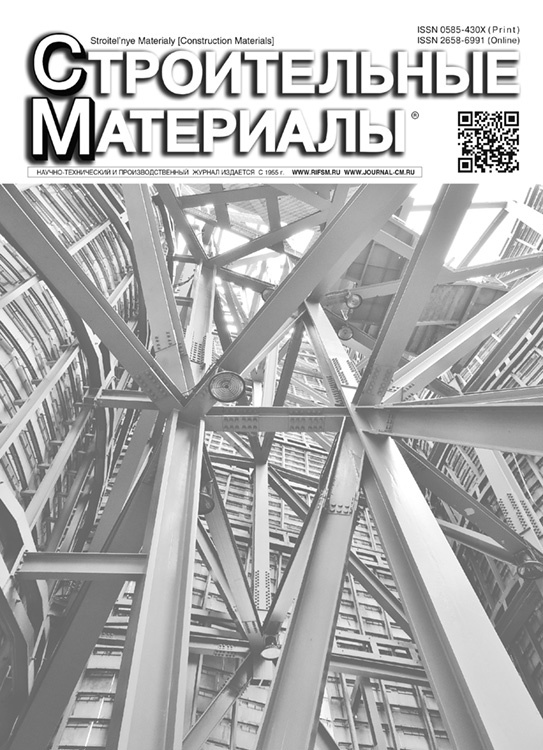Regularities of structure formation of composite materials based on polystyrene foam and lignin-containing waste
- Autores: Smirnova O.E.1, Pichugin А.P.1
-
Afiliações:
- Novosibirsk State University of Architecture and Civil Engineering (SIBSTRIN)
- Edição: Nº 7 (2025)
- Páginas: 72-79
- Seção: Статьи
- URL: https://transsyst.ru/0585-430X/article/view/688703
- DOI: https://doi.org/10.31659/0585-430X-2025-837-7-72-79
- ID: 688703
Citar
Texto integral
Resumo
This article discusses issues related to the formation of the structure of composite materials. The effect of using a single-component and combined organic filler in the composition of a composite is studied using IR spectral analysis. The mechanism of π-stacking interaction during the formation of an adhesive shell of a polystyrene foam granule is presented. The process of forming the macrostructure of a composite with the introduction of an organomineral binder is considered. To study the effect of nanosized additives on composites, the results of thermomechanical studies are presented using the method of measuring the deformation of uniaxial compression under the influence of a continuously acting load under conditions of heating the sample at a constant rate. The nature of the influence of modifying polystyrene foam granules on ensuring the dense structure of the material has been established. The introduction of modified polystyrene foam granules causes the ordering of the composite matrix due to the construction of a complex structure-forming system that plays the role of a framework. Based on wood-plant and polystyrene foam fillers, compositions of heat-insulating and structural heat-insulating materials with a density of 250–600 kg/m3, thermal conductivity of 0.035–0.135 W/(moC), compressive strength up to 2.8–4.5 MPa, bending strength up to 1.5–2 MPa were obtained.
Palavras-chave
Texto integral
Sobre autores
O. Smirnova
Novosibirsk State University of Architecture and Civil Engineering (SIBSTRIN)
Autor responsável pela correspondência
Email: smirnova.olj@yandex.ru
Candidate of Sciences (Engineering)
Rússia, 113, Leningradskaya Street, Novosibirsk, 630008А. Pichugin
Novosibirsk State University of Architecture and Civil Engineering (SIBSTRIN)
Email: gmunsau@mail.ru
Doctor of of Sciences (Engineering), Professor
Rússia, 113, Leningradskaya Street, Novosibirsk, 630008Bibliografia
- Khozin V.G., Khritankov V.F., Pichugin A.P. The role of the construction industry in the formation of the circular economy of industrial regions of Russia. Stroitel’nye materialy [Construction Materials]. 2021. No. 1–2, pp. 6–12. (In Russian). EDN: FVBKYO. https://doi.org/10.31659/0585-430X-2021-788-1-2-6-12
- Arzhakova O.V., Yarysheva A.Yu., Nazarov A.I., Dolgova A.A., Volynskii A.L. Preparation of a new hard-elastic polymeric material based on ultra-high-molecular-weight polyethylene. Doklady Physical Chemistry. 2023. Vol. 510. No. 2, pp. 100–105. EDN: ZCVZFY. https://doi.org/10.1134/s0012501623600067
- Elesin M.A., Mashkin N.A., Khritankov V.F., Karmanovskaya N.V. Analysis of creep of wood-polymer composites. IOP Conference Series: Materials Science and Engineering. 2021. Vol. 1079. No. 4, pp. 042022. EDN: MKHJGC. https://doi.org/10.1088/1757-899x/1079/4/042022
- Sazanov Yu.N. Lignin-polymer composites. Izvestiya Vysshikh Uchebnykh Zavedeniy. Lesnoy Zhurnal. 2014. No. 5 (341), pp. 153–172. (In Russian). EDN: SWKEEL
- Chernov V.Yu., Sharapov Ye.S., Mal’tseva Ye.M., Pegushina Ye.N. Study of the influence of thermal modification of wood on the adhesive and strength properties of wood-cement composite. Vestnik MGSU. 2023. Vol. 18. Iss. 9, pp. 1394–1407. (In Russian). EDN: EILILM. https://doi.org/10.22227/1997-0935.2023.9.1394-1407
- Volynskiy A.L. Strukturno-mekhanicheskiye osobennosti stekloobraznogo sostoyaniya amorfnykh polimerov [Structural and mechanical features of the glassy state of amorphous polymers]. Moscow: Izdatel’skiy dom KDU, Dobrosvet. 2020. 54 р. EDN: YLACZJ. https://doi.org/10.31453/kdu.ru.91304.0106
- Solomatov V.I., Vyrovoy V.N., Selyaev V.P. Polistrukturnaya teoriya kompozitsionnykh stroitel’nykh materialov [Polystructural theory of composite building materials]. Tashkent: Fan. 1991. 345 р. EDN: RXBAPD
- Pichugin A., Pchelnikov A., Smirnova O., Tkachenko S. Influence of Surface Tension Forces of Modifiers on Some Properties of Composite Materials. Proceedings of the 6th International Conference on Construction, Architecture and Technosphere Safety. ICCATS 2022. Lecture Notes in Civil Engineering. 2023. Vol. 308. EDN: IWSGGS. https://doi.org/10.1007/978-3-031-21120-1_26
- Gornostayeva Ye.Yu., Lasman I.A., Fedorenko Ye.A., Kamoza Ye.V. Wood-cement composites with modified structure at macro-, micro- and nanolevels. Stroitel’nye materialy [Construction Materials]. 2015. No. 11, pp. 13–16. (In Russian). EDN: VCIDVJ
- Patent RF 2790089. Sposob polucheniya legkogo granulirovannogo materiala [Method for producing lightweight granular material]. Pichugin A.P., Khritankov V.F., Smirnova O.Ye. Declared 29.11.2021. Published 14.02.2023. (In Russian). EDN: FIZHAM
- Kuznetsov V. P., Baumgarten M. I. Adhesion in adhesive joints: adhesion from the standpoint of strength theory. Vestnik of the Kuzbass State Technical University. 2014. No. 4 (104), pp. 97–102. (In Russian). EDN: SJFWKF
- Smirnova O.E., Pichugin A.P., Khritankov V.F. Adhesive strength in the structure of composite materials based on organic raw materials. Stroitel’nye materialy [Construction Materials]. 2024. No. 5, pp. 17–21. (In Russian). EDN: ISJUZJ. https://doi.org/10.31659/0585-430X-2024-824-5-17-21
- Hill C., Altgen M., Rautkari L. Thermal modification of wood — a review: chemical changes and hygroscopicity. Journal of Materials Science. 2021. Vol. 56. Iss. 11, pp. 6581–6614. EDN: LIWEWD. https://doi.org/10.1007/s10853-020-05722-z
- Lapidus A.A., Fedosov S.V., Bulgakov B.I., Petrukhin A.B., Kenevei E. Energy-saving technology for the production of structural and thermal insulation arbolite based on biomass for developing countries (on the example of the Republic of Chad). Stroitel’noye Proizvodstvo. 2024. No. 2, pp. 100–107. (In Russian). EDN: BYGBZY
Arquivos suplementares
















